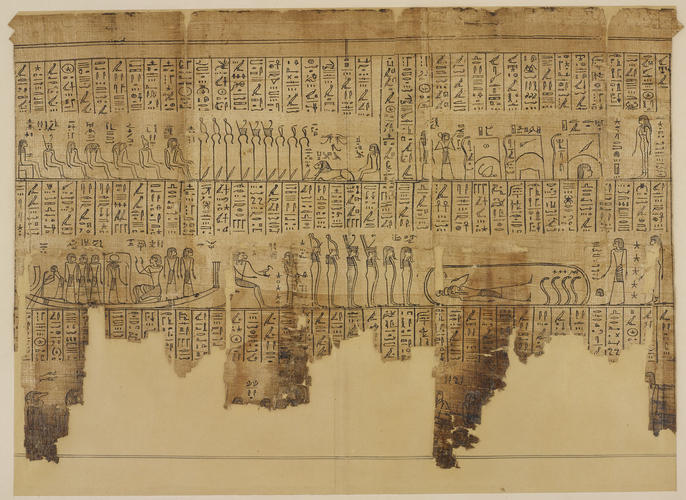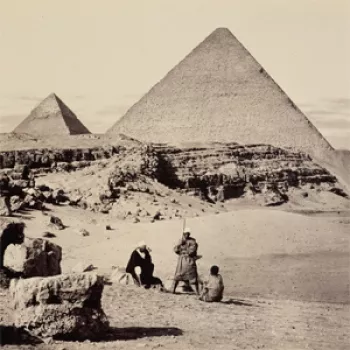Section of the papyrus belonging to Nesmin, with the sixth hour of the Amduat c.300-275 BC
61.5 x 80.5 cm (mount) (whole object) | RCIN 1145261
-
Section of the papyrus belonging to ‘God’s Father and Prophet of Amun-Ra, King of the Gods, Nesmin, born of the Lady of the House, Sistrum-player of Amun-Ra, Tasherit(en-ta)ihet’ with the sixth hour of the Amduat (see also RCINs 1145259-66).
The Amduat (literally ‘that which is in the netherworld’), also known as the Book of the Hidden Chamber, is a funerary text that describes the journey of regeneration of Ra, the Egyptian sun god, through the 12 hours of the night from sunset (symbolising death) to sunrise (symbolising rebirth). The text starts appearing in royal tombs from around 1500 BC, and the two most notable examples are perhaps those painted on the walls of the burial chambers of Thutmose III (1479–1425 BC) and Amenhotep II (1427–1400 BC) in the Valley of the Kings, Thebes. It represents an important stepping stone in the literary tradition of ancient Egypt, being the model for later Books of the Afterlife, and it maintains its relevance well into the Graeco-Roman era.
The main aim of the text is to offer a description of the netherworld so that the deceased, as well as the living, are able to gain familiarity with what to expect when their journey into the afterlife begins. Knowledge of the secret paths of the netherworld offers protection to the deceased from the dangers and threats he/she may encounter; the text shows the obstacles and demons that could obstruct a safe passage through the hereafter as well as the deities and beings able to assist and help the deceased towards the completion of the journey of regeneration.
The sixth hour of the night (midnight) contains the main and focal moment of the Amduat: the actual moment of renewal of Ra with the reunion of his ba-soul with his corpse, described in the text as the union of Ra with Osiris. Re's solar barque (Mesektet) has left the desert land of Seker and entered a new region, deeper and darker, called the 'waterhole of those of the netherworld' where the presence of the primeval ocean Nu offers the necessary regenerative powers to start a new life. The goddess is depicted twice in the lower register, as a crocodile-headed deity paired with Sobek on the left-hand side of the register and in her full human form on the right-hand end.
The moment of renewal of life is depicted in the middle register with the corpse of the sun god lying horizontally encircled by a multi-headed serpent (a snake forming a circle with, usually, its tail in its mouth, also known as ouroboros, is a symbol of cyclicality and constant re-creation). The sun god is depicted in a non-mummy form and with a scarab beetle, or Khepri, on his head (the usual symbol for regeneration, being Khepri the rejuvenated morning form of the god). Interestingly, the sun god has also one hand pointing to his mouth which is the hieroglyphic sign for 'child'.
This moment follows that of dismemberment of his body, clearly alluding to that of Osiris, as depicted on the upper register, directly above the ouroboric serpent. Here is the triple burial of the sun god with three chests containing the hind part of a lion, the wing of a scarab and a human head. The chests are open near the top and each is guarded by a fire-spitting snake. Death, decay and dissolution, represented by the burial of the dismembered parts of the sun god, precede and are necessary to the complete renewal of Ra. The relating text reads 'Illuminated is the darkness in the earth! The flesh roars with joy, and the head speaks, after he has united his members. These are the mysterious images of the netherworld.'
Egyptologist Samuel Birch published his study of the papyrus in 1863 (RCIN 1079232). A facsimile was published in 1913 with the hieroglyphic transcripts, translations and an introduction by E.A. Wallis Budge.
A more recent English translation of the complete text of the Amduat can be found in Hornung, E and Abt, T eds, 2007. The Egyptian Amduat. The Book of the Hidden Chamber. Zurich: Living Human Heritage, while a psychological interpretation of the text is presented in Schweizer, A, 2010. The Sungod’s Journey through the Netherworld. Reading the Ancient Egyptian Amduat. Ithaca, NY and London: Cornell University Press.Provenance
Excavated in Egypt at the Dra' Abu el-Naga' necroplis, near Deyr el-Bahri, part of the larger Theban necropolis, 1862 by Mustafa Aga Ayad, consular agent to the United Kingdom. Acquired by King Edward VII, when Prince of Wales, during his 1862 tour of the Middle East.
-
Measurements
61.5 x 80.5 cm (mount) (whole object)
86.5 x 67.0 cm (book in box)
39.2 x 57.7 cm (sheet of paper)
Category
Alternative title(s)
Passage of the sun through an hour of the night ; 3. (Papyrus of Nas-Khem Priest of Amen-Ra).











